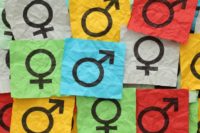Current reality of Gender Equality in the world

Even in this contemporary world where mankind has splendid credits to its name for all sorts of technological development yet the very basic aspect of human society in form of ‘gender equality’ is compromised. The understanding and recognition of the fact that women deserve the same quality of life as of men at large have rarely been educated and accepted. Without equal status in society, improvement in quality of life can never be achieved, particularly where half of the world’s population comprises of women and girls. Through continuous human efforts in different part of the world in both, developed and under developed countries several rights which were previously regarded solely for men, have been extended to women. Nevertheless, the complete eradication of gender disparity is still in its early stages in many parts of the world.
According to an analytical report1 issued by the World Bank, out of 141 countries, 24.1% countries have no legislation on domestic violence, where as 13.5% countries have no legislation that specifically address sexual harassment. In the chart below; a data has been drawn to further quantify the lack of protection against sexual harassment in employment, education and public places over a period of time;
Even though the figures depict slight improvement, there are millions of women lacking legal protection against sexual harassment for 2017, in employment, education, and public places are at 362 million,
1.5 billion, and 2.2 billion, respectively. The report further defines the economic violence that is faced by women whereby they are forcefully restrained from working and having an independent source of income. A recent report2 issued by UN Women provides that there are 18 countries where husbands can legally prevent their wives from work. In other words in those countries the economic violence is being protected by the country’s law and establishment.
The international humanitarian organizations in consultation with local bodies have been collecting and analyzing immense data since decades and setting achievable goals from time to time. However due to the gravity and complexity of the issues pertaining to gender disparity the complete eradication has not been achieved as yet.
Gender equality can be enhanced by increasing women’s decision-making and participation in economic, political and social processes. Encouraging them to build opinion, access education and have a voice in matters that affect them in any way. They should be given better access to resources in form of improved level of education and skill. As per a data fact sheet of UN Women report2, worldwide there are more male internet user than females. Both genders are worthy of equal opportunities in terms of health and safety. Unfortunately, in the year 2015, 303,000 women died due to pregnancy related issues, similarly in almost two thirds of countries, women are more likely than men to report food insecurity.
The International Labor Office reports3, the gender wage gap is as wide as 23%, which further explains why women and girls are over represented among the poor. There are disparities even in hourly wage rates and have been documented in the report to be 10%, which means women earn 90% of what men earn. Along with the need to fulfill the social and personal responsibilities, there are many other factors attributed to explain the wage gap prevailing in the world, such as education, age, undervaluation of women work, practice of discrimination, and career breaks. The progress in minimization of this gap is slow and it can take up to 70 years to remove the gap completely. The issues such as gender pay gap cannot be correlated to a country’s social or economic development, rather it pertains to many economically developed countries as well.
Despite the fact that in many countries these days, women have the required education and skill set for the jobs, yet they face multiple barriers and lack equal involvement in labor market. Similarly, the retirement benefits are not at par and around 200 million old women are living without any regular pension income which turns out to be 85 million more than the men living without regular pension income in the world.
The current reality of gender equality might still be bleak, however as compared to the past progress has been made in a number of areas. Ending gender disparity is the utmost human right and both men and women deserve equal opportunities. There exist inequalities in participation in labor market, wage gaps, availability of economic resources, decision making authority and representation, likewise the underlying issues of sexual and economic violence need to be resolved. The issues are so deep rooted that it requires nothing less than a radical change in underlying thought process. Institutions at large should commit to basic awareness of human rights in terms of gender equality and provide for social justice and inclusivity, as well as the governments should take every possible measure in order to eradicate the unjust social phenomena, only then the equitable distribution of economic gains can be ensured and a just society can prevail.
By: Sahrish Wajahat
- Ending violence against women and girls: Global and regional trends in women’s legal protection against domestic violence and sexual harassment: Paula Tavares and Quentin Wodon
- “Turning promises into action: gender equality in the 2030 agenda for sustainable development”
- Women at work Trends- 2016, International Labor Office – ILO Geneva
Sahrish Wajahat ACA
A freelance consultant, with more than 8 years of post-qualification experience. Served in various capacities at several external/internal audits, accounting reviews and consultancies of development, educational and government sector.







